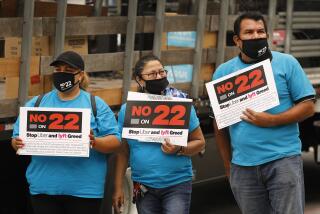Judge Limits Damage Awards in Cerritos Air Crash : Courts: The ruling may save the U.S. government millions in payments to victims of the 1986 disaster.
In a decision that could save the U.S. government millions of dollars, a federal judge Thursday ruled that Proposition 51--the so-called “Deep Pockets Limitation” initiative passed by California voters, limits the amount of damages that can be recovered from the 1986 Cerritos air crash in which 82 people died.
U.S. District Judge David V. Kenyon of Los Angeles ruled that Proposition 51 applied to “non-economic” damages sought in about 75 cases stemming from the crash.
The ruling had been anxiously awaited by lawyers for the Federal Aviation Administration and plaintiffs--including relatives of the deceased and homeowners who lost their houses in the crash.
The suits were filed after the Aug. 31, 1986, crash in which an Aeromexico DC-9 jetliner collided with a small plane over Cerritos.
In April, a federal court jury in Los Angeles held that the FAA and the pilot of the small plane were equally responsible for the crash and absolved Aeromexico of any blame. The Justice Department then filed papers asserting that Proposition 51 applied to the case.
Proposition 51, passed by voters in 1986, held that in any personal injury or wrongful death lawsuit, where more than one party was at fault, the liability of each defendant for non-economic losses were limited to the percentage of fault that each party bore. Such losses include pain and suffering or loss of relations with one’s spouse of children.
For example, if a party was 50% at fault, they would bear only up to 50% of the non-economic damages.
Prior to Proposition 51, if one of the parties had little money, the other defendant had to absorb the bulk of the damages, regardless of the percentage of fault.
Proposition 51 did not alter the way that economic damages--such as loss of wages, medical bills and property damages--are handled. Plaintiffs are still able to fully recover all those damages from the defendants, regardless of how much at fault they were.
Kenyon’s decision is of considerable significance in the Cerritos case because there is a vast difference between the resources of those who were deemed at fault. The estate of William V. Kramer, pilot of the small plane who died in the collision, has $1 million, while the federal government potentially has endless resources.
The victims’ lawyers asserted that the intent of Proposition 51 was only to reduce the amount of damages that could be recovered by a plaintiff who was partly at fault, not to limit damages to a party that was an innocent victim. But Kenyon disagreed.
“There is nothing in the statute or the arguments given for and against its passage that would lead to the conclusion that Proposition 51 is inapplicable to cases involving an innocent plaintiff,” Kenyon wrote.
The judge added that “the major purpose” of the initiative was to rectify a perceived inequity in the law that was costing California cities, counties and other government entities millions of dollars in personal injury lawsuits where they were only partly at fault.
Proposition 51 was designed to “create a compromise” between the interests of an innocent plaintiff and a “deep pocket” defendant, such as a city, Kenyon wrote.
He said if the plaintiff’s argument prevailed, it would undermine the purpose of the law.
“As one of the deep-pocket defendants that everyone is always trying to sue, it’s important for the federal government that the court gave this interpretation to Proposition 51,” said Steven J. Riegel, the Justice Department lawyer who handled the case.
More to Read
Sign up for Essential California
The most important California stories and recommendations in your inbox every morning.
You may occasionally receive promotional content from the Los Angeles Times.









